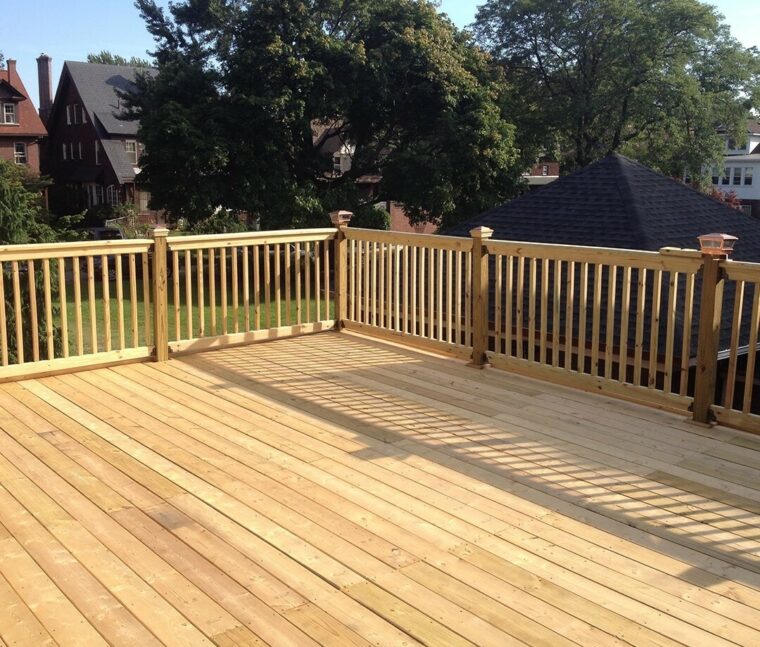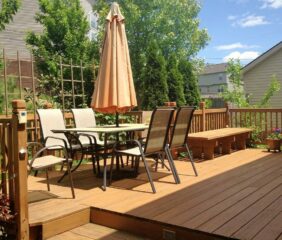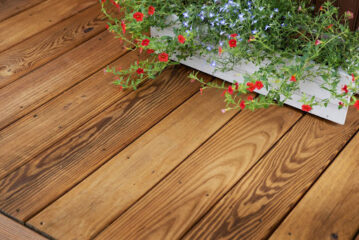Wood has long been considered a timeless decking material, so it’s no surprise that it is still one of the most popular decking materials on the market. However, while it’s incredibly popular, it does require continual upkeep to keep it looking well-maintained. Traditional options for wood decking maintenance include clear sealer, stain or paint.
When it’s time to choose a finish for a deck, it’s important to understand the difference between available products to decide which is better for your specific project.
Should you paint or stain your deck? Much of the decision between deck paint or stain comes down to personal preference, the desired final look, and the amount of protection and coverage needed.

Is There a Difference Between Paint and Stain?
Although they do share some similarities, there are a number of differences between paint and stain, including their composition, amount of coverage and site preparation.
Paint
Paint is made up of four components — solvent, resin, additives and pigment. The solvent is the liquid part of the paint. In water-based latex paint, water is the solvent. Mineral turpentine is typically used as the solvent for oil-based paints. As the solvent evaporates, the other components are left behind.
Resins are the binders that adhere the paint to the surface after the solvent has evaporated. Additives are added to the paint to give it desired properties such as faster drying times, reduced mold growth or smoother brush strokes.
The color of the paint is due to the pigments. Different powdered colorants are combined with water and then added to the paint and mixed in different ratios to create a wide range of colors

Stain
The composition of stain is largely the same as paint — solvent, resin and pigments. Instead of the paint sitting on top of the surface, a stain is formulated to penetrate the wood and reveal the natural beauty of its grain and texture. Stain comes in three finish options — transparent, semi-transparent and opaque.
Opaque, or solid color stains, contain more pigment than the transparent or semi-transparent types and will cover the grain while still showing the wood texture. Clear stains don’t contain any pigment, allowing the true beauty of the natural wood to come through. Since they don’t contain pigment, they offer less protection than semi-transparent or solid wood stains.
If you’re having trouble deciding between solid or clear, then semi-transparent is the ideal compromise. It offers more protection than clear stain while revealing more of the wood grain and texture than solid stains. You can also choose the color that best compliments the home.

Many stains are oil-based, containing alkyd resins, linseed oil or tung oil or a mixture of the three. These stains penetrate the wood more deeply than water-based stains, but they can fade faster. Water-based stains may last longer, but they require more site preparation to prepare the wood to absorb the stain.
Benefits of Deck Stain vs. Paint
If the deck is made with pressure-treated woods, the stain will adhere better than paint. If pressure-treated woods are used, stain seeps into the deck, becoming a part of the deck rather than an added layer, which means that it won’t chip, crack or flake.
On the other hand, paint doesn’t flex as the wood of the deck expands and contracts in response to heat, cold and moisture, which can lead to peeling and additional maintenance throughout the year. To properly paint a deck, a primer should be applied first, followed by the paint — usually two coats — and then finished with a sealant.
Stain typically only requires one coat, and it can include a sealer to give you a sealed and stained deck quickly. It also adds a measure of slip resistance whereas paint can become slippery in wet conditions.
Paints offer a nearly endless range of colors and sheens, so you can choose a high gloss yellow, a matte green or anything in between. Stain is typically thought of as being wood-toned, but the truth is that stains can also range in colors from yellows to greens to blues. Stains can also be opaque, semi-transparent and transparent — giving you ultimate design flexibility.

How Often Should a Deck Be Painted or Stained?
Decks should be stained every few years to maintain the look and protection that stain creates on the deck. A painted deck will only need to be refinished about every 10 years.
However, regardless of the stated longevity of any products, it is important to inspect for damage, periodically. If the paint has chipped or peeled or the stain has faded, then it’s important to address these issues as soon as possible.
The longevity of paint or stain is also affected by deck maintenance. Quickly removing leaves, snow or other debris will protect the deck from moisture, reducing the likelihood of mold growth, peeling or fading.
What to Look for in a High-Quality Paint and Stain
When you’re choosing paint or stain for the deck, look for a high-quality product that is tailored to your specific application. ZAR® has paints and stains that are tailor-made for specific deck conditions and transparency needs.
For new wood decks and those that have been previously stained or coated, much of the decision rests on the transparency level that you want.

For full coverage, ZAR® Deck & Siding Solid Color Coating will create a solid color stain and should be applied in two coats. If you’re on the fence between paint and stain and wish that there were a range of color options in stain form, then this is the one to check out. Offering a variety of colors, you can have the best of both worlds — the color of paint with the beauty of wood texture without the grain.
If you want protection but also want the beauty of the wood grain to show, then ZAR® Deck & Siding Semi-Transparent Stain is the way to go, as it offers subtle color ranging from weathered Barnboard to rich Rustic Brown.
To protect the deck and reveal the natural warmth and beauty of wood, ZAR® Deck & Siding Clear Waterproof Wood Sealer accents the natural grain, texture and color of the wood. You only need one coat, but adding a second will deepen the color and bring out a soft sheen.
If you’re tackling an aged wood deck in poor condition, then ZAR® NuDECK® Wood and Concrete Restorative Coating will provide superior protection, and create a new, mildew- and slip-resistant surface. This water-based paintable product fills cracks and nail holes and locks down splinters on an aged or damaged wood surface, creating a new finish that is both beautiful and durable.
ZAR® by UGL® Produces Premium Paint and Stain
ZAR® by UGL® makes premium products. If you’re deciding between paint or stain deck finishes, you’re guaranteed to get a product that will create a beautiful finish on any deck from new and previously stained, to aged decks in need of some extra care.
Reach out to the experts at ZAR® today to find the perfect deck paint or stain for your project.



